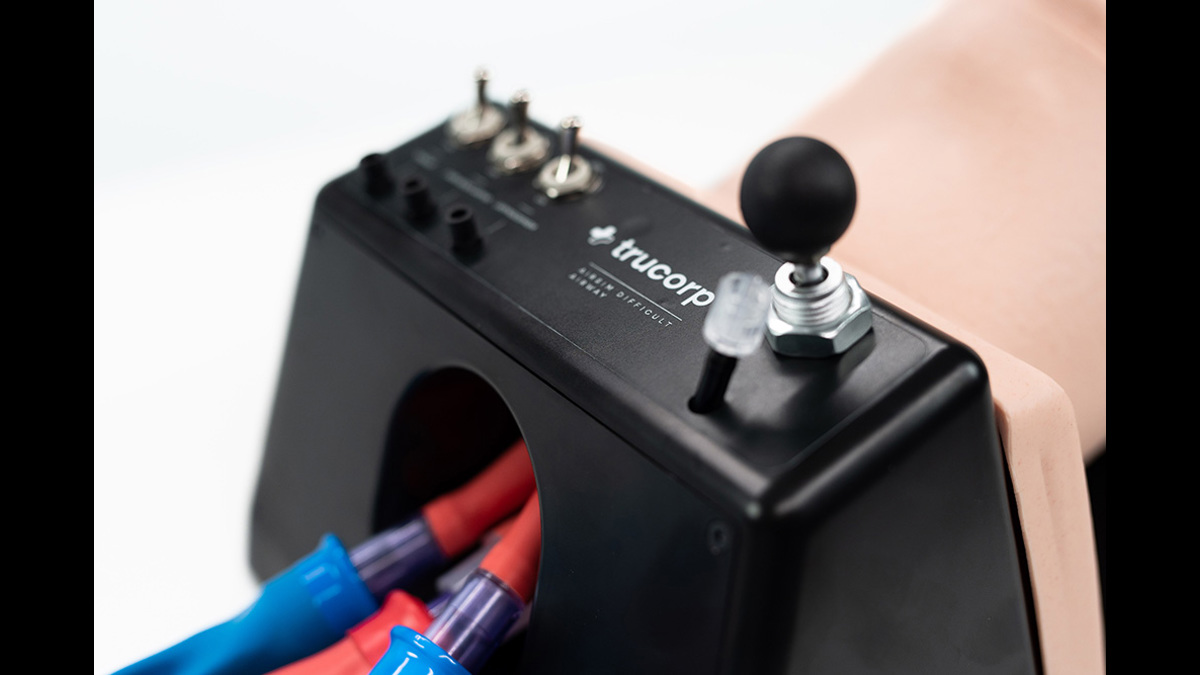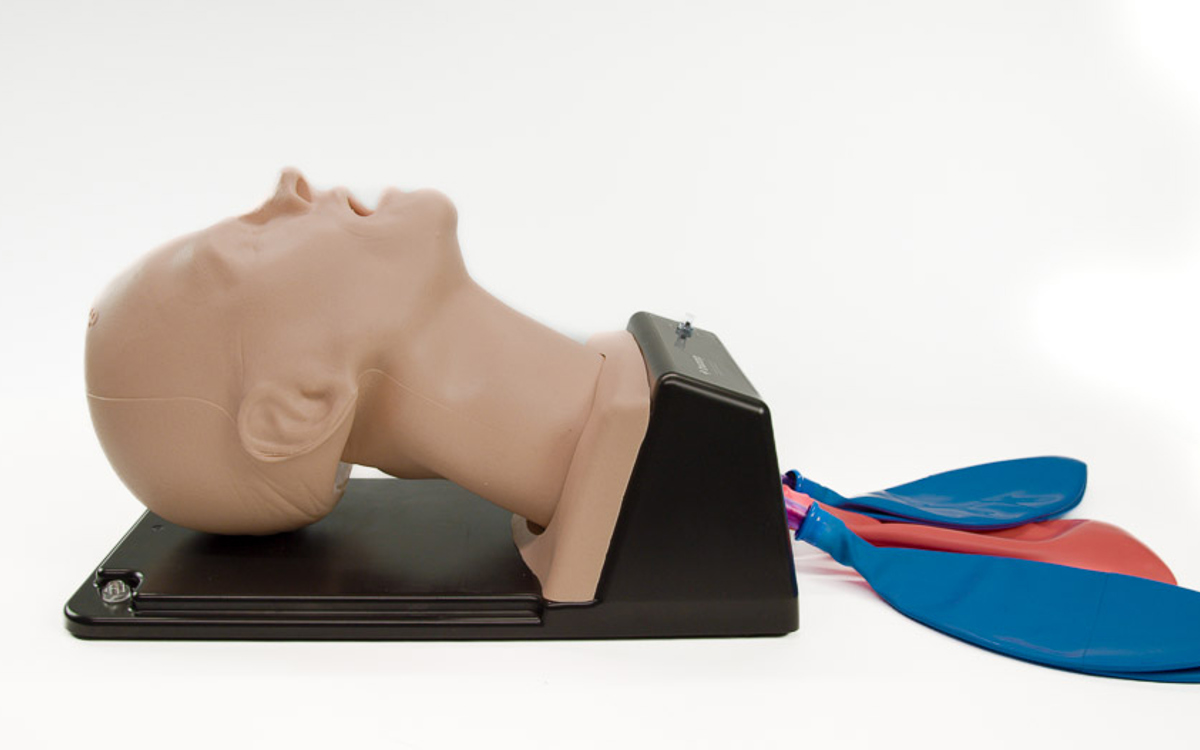








AirSim Difficult Airway Training Manikin (Light Skin Tone)
Skin Tone
Model
Adding to cart...
Added to cart
Sorry, something went wrong adding the product to the cart.
The AirSim Difficult Airway Trainer has been designed in accordance with the DAS guidelines to aid in the improved management of unanticipated difficult intubations, and is the most realistic trainer on the market.
TruCorp’s intubation manikin is an excellent solution for airway management, front of neck access (FONA) devices, and emergency FONA techniques.
Compact and accessible, this airway simulator incorporates multiple features with minimal set up time between training sessions.
To operate the different features of the Difficult Airway Manikin, the base has been equipped with a clear and simple pump system. The hose can be attached to any of the three mechanisms to inflate and simulate different pathologies. The pathologies can be used simultaneously to increase the degree of difficulty
The AirSim Difficult Airway Trainer has been designed in accordance with the DAS guidelines to aid in the improved management of unanticipated difficult intubations, and is the most realistic trainer on the market.
TruCorp’s intubation manikin is an excellent solution for airway management, front of neck access (FONA) devices, and emergency FONA techniques.
Compact and accessible, this airway simulator incorporates multiple features with minimal set up time between training sessions.
To operate the different features of the Difficult Airway Manikin, the base has been equipped with a clear and simple pump system. The hose can be attached to any of the three mechanisms to inflate and simulate different pathologies. The pathologies can be used simultaneously to increase the degree of difficulty
Difficult Airway Features
Laryngospasm – Fully adjustable from normal to complete obstruction of the airway, simulates closure of the vocal cords, and obstructions can be reverse to provide positive feedback upon successful trainee actions.
Tongue Edema – Tongue can be inflated to simulate various degrees of tongue angioedema.
Displaced Larynx – Larynx insert can be adjusted to an anterior position, increasing the difficulty of visualising the vocal cords.
Lockjaw & Jaw Position – The mechanism of the jaw allows the trainer to change the difficulty of scenarios with lockjaw, overbite and underbite, as well as free moving to replicate jaw thrust.
Head Rotational Lock – As standard the model allows for head rotation, the head can also be locked in position to make rotation impossible.
Overview
- Designed for unanticipated difficult intubations as outlined in the Difficult Airway Society guidelines
- Offers a variety of scenarios that are suitable for beginners through to advanced users
- Manikin construction allows trainers to create more challenging tasks quickly and effortlessly
- Part of Trucorp's range of adult airway management training manikins
Realism
- Improved skin texture to give a true to life training experience
- Internal anatomy of the airway includes an enlarged tongue, swollen posterior cartilages and an elongated epiglottis
- Larynx inserts features palpable tracheal rings
Versatility
- Pump system allows for varying degrees of difficulty of Laryngospasm, Tongue Edema and Displaced Larynx
- Easy to use toggle system to switch between conditions
- Neck skin can be rotated for multiple uses
- Larynx membrane inserts are easily replaceable, each model comes with 5 inserts, with 1 already in place within the model
Cleaning
- Thoroughly clean the airway with warm, soapy water or mild detergent, until foreign matter and residue is removed
- As a further step to fully sanitise the product, use an alcohol spray (75%+) and wipe off (This can be performed on both the silicone and latex parts of the manikin)
Safety
- Some parts within this model contain latex
- Ensure use of protective gloves when using the latex airway
- Spray lubricant provided on the airway and equipment prior to use, to aid the procedure and reduce risk of damage to the material
- Do not use strong detergents or enzymatic cleaning agents on this trainer, such as, germicides, disinfectants, chemical agents, ethylene oxide, phenol-based or iodine-containing cleaners
Recommended equipment:
- 7.0-7.5mm ID for nasal intubation
- 8.0-9.0mm ID for oral intubation
- LMA laryngeal masks, sizes 3-5
Anatomy
- Representation of an adult head and neck in a supine position
- Airway, including trachea
- Lungs
- Stomach
Skills Gained
- Needle cricothyroidotomy
- Surgical cricothyroidotomy
- Percutaneous tracheostomy
- Double naso-tracheal intubation
- Bag valve mask (BVM) ventilation techniques
- Use of the full range of supraglottic devices
- Direct laryngoscopy
- Endotracheal tube insertion
- Awake fibre optic examination
- Combi tube insertion
- Video laryngoscopy, including Sellick Manoeuvre
- Naso-gastric tube insertion
Learning skill for dealing with:
- Laryngospasm
- Displaced larynx
- Tongue edema
- Receding/protruding mandible
- Trismus
Product Contains
Also includes:
- 1 Wrap Around Neck Skin (replacements are available in pack of 5)
- 5 Larynx Inserts - 1 supplied in the manikin, 4 spare (replacements are available in packs of 50)
- Adhesive pads for stabalisation
How difficult is it to put the TruCorp Difficult Airway simulator together?
Despite providing multiple pathologies, the Difficult Airway simulator is very easy to use during training.
When you order this AirSim manikin, it will come fully assembled and ready to use straight from the box. The only preparation needed is to attached the suction cups or adhesive pads to the base, secure the manikin to the work surface, and apply lubricant to the airway and equipment.
Disruption between procedures is minimal:
- Neck skin needs to be rotated to allow for a fresh section of skin over the trachea, simply undo the Velcro fastening, rotate and resecure (Note: rotating the skin will increase the life of the consumable)
- Larynx inserts vary in life span depending on procedure. Replace the insert after 1 surgical cricothyroidotomy or 2-3 percutaneous tracheostomy procedures. Remove the neck skin and larynx insert, align the new larynx and press into place, and replace the neck skin
____________________________________
How will the trainee know if they have successfully performed their procedure?
A successful intubation will result in the two lungs bags inflating. If they have placed the tube incorrectly in the oesophagus, the stomach bag will inflate.
____________________________________
What are the ongoing costs associated with the Difficult Airway trainer?
This will depend on the types of procedures that you are training in. Consumables for this trainer include lubrication, neck skins, and larynxes, which are available to buy in packs, please see the “Works With” tab for more details.
____________________________________




















